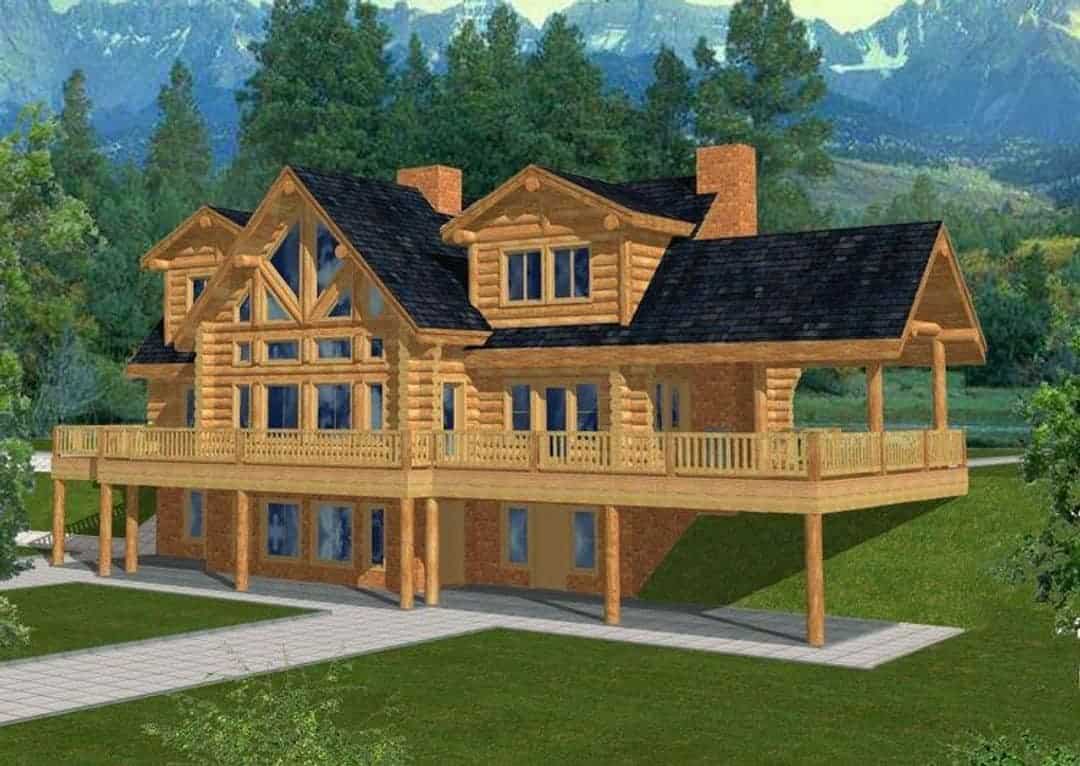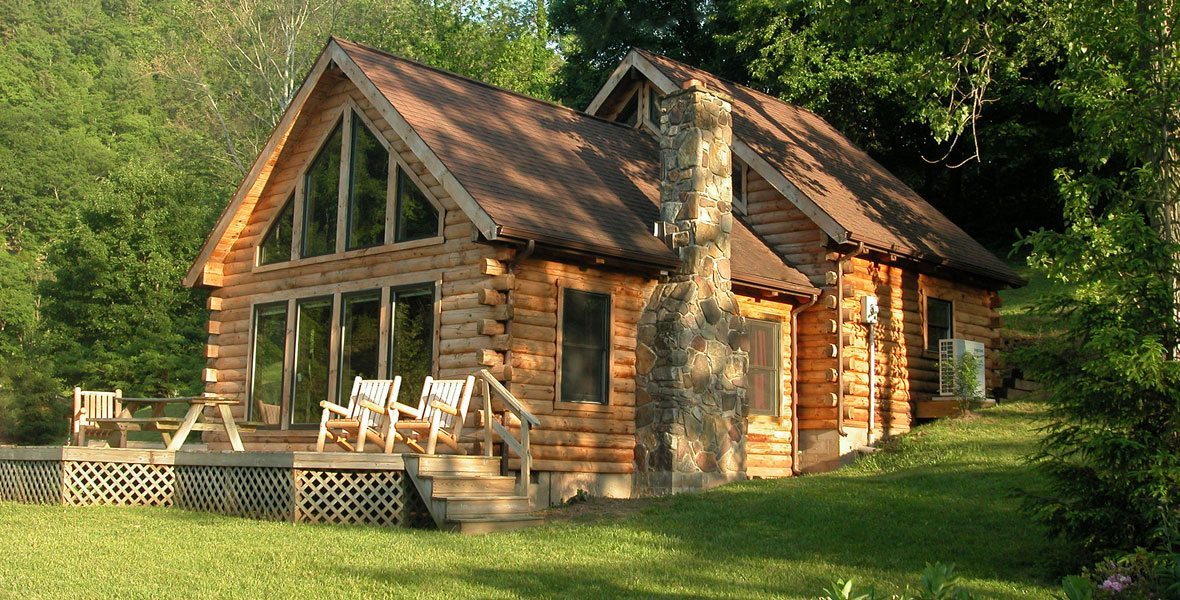The Allure of Log Cabin Living

There’s a certain magic that surrounds log cabins. Perhaps it’s the rustic charm, the undeniable connection to nature, or the promise of tranquility that draws us in. Log cabins, with their timeless appeal, offer a unique living experience that resonates with many.
History and Evolution of Log Cabin Architecture
Log cabin architecture, born out of necessity, has a rich history spanning centuries. The earliest log cabins, constructed by early European settlers in North America, served as practical shelters. Over time, this simple, yet sturdy, construction method evolved, incorporating elements of local traditions and modern building techniques. The iconic log cabin, with its distinctive horizontal logs interlocked at the corners, became a symbol of frontier living and self-reliance. Today, log cabins are not merely functional structures but often represent a lifestyle choice, embracing nature and simplicity.
Advantages and Disadvantages of Log Cabin Living
Log cabins offer a distinct set of advantages and disadvantages compared to traditional homes.
Advantages
- Rustic Charm and Natural Beauty: Log cabins exude a timeless charm and blend seamlessly with natural surroundings. The warmth of wood, the unique grain patterns, and the cozy atmosphere create a welcoming and inviting ambiance.
- Energy Efficiency: The thick walls of a log cabin provide excellent insulation, helping to regulate temperature and reduce energy consumption. This can lead to significant savings on heating and cooling costs.
- Durability and Longevity: Log cabins are known for their durability and longevity. Properly constructed and maintained, they can withstand the test of time and last for generations.
- Connection to Nature: Log cabins often evoke a sense of connection to nature. Their rustic charm and proximity to natural elements provide a tranquil and peaceful living experience.
Disadvantages
- Maintenance Requirements: Log cabins require regular maintenance to preserve their beauty and integrity. This includes sealing, staining, and treating the wood to prevent moisture damage and insect infestations.
- Limited Space: Traditional log cabins, due to their construction method, can sometimes have limitations in terms of space. Modern log cabin designs often incorporate open floor plans and vaulted ceilings to maximize space.
- Cost: Building a log cabin can be more expensive than constructing a traditional home, especially if custom-built or using high-quality logs.
Designing a 2-Bedroom, 2-Bath Log Cabin: 2 Bedroom 2 Bath Log Cabin

Designing a 2-bedroom, 2-bath log cabin requires careful consideration of space optimization, layout, and functionality to create a cozy and comfortable living space. While log cabins are known for their rustic charm, they can be designed to accommodate modern amenities and contemporary aesthetics.
Space Optimization and Layout
Space optimization is crucial in a log cabin, especially for a 2-bedroom, 2-bath design. A well-planned layout ensures maximum functionality and minimizes wasted space. Here are some key considerations:
- Open Floor Plan: An open floor plan can create a sense of spaciousness, especially in smaller cabins. Combining the living, dining, and kitchen areas can make the space feel larger and more inviting.
- Efficient Kitchen Design: A compact and efficient kitchen layout is essential for a small cabin. Consider using a galley-style kitchen or a peninsula design to maximize countertop and storage space.
- Multifunctional Furniture: Utilize furniture that serves multiple purposes, such as a sofa bed or a coffee table with built-in storage. This maximizes space and provides flexibility.
- Built-in Storage: Incorporate built-in storage solutions, such as shelves, cabinets, and drawers, to keep belongings organized and out of sight.
Architectural Styles
Log cabins can be designed in various architectural styles, each with its unique features and aesthetics. Here are some popular styles suitable for 2-bedroom, 2-bath log cabins:
- Rustic: The classic rustic style features exposed beams, rough-hewn logs, and a simple, natural aesthetic. Examples include a traditional A-frame cabin with a large stone fireplace.
- Mountain: Mountain-style log cabins often feature steep roofs, large windows, and a cozy, inviting atmosphere. They typically incorporate elements of nature, such as stone accents and wood paneling.
- Contemporary: Contemporary log cabins combine the rustic charm of logs with modern design elements. They may feature clean lines, open floor plans, and large windows that showcase natural views.
- Craftsman: Craftsman-style log cabins emphasize natural materials, handcrafted details, and a focus on functionality. They often feature exposed beams, built-in cabinetry, and a warm, inviting atmosphere.
Interior Design Elements
The interior design of a log cabin can significantly impact its overall feel and ambiance. Here is a table showcasing common interior design elements, including materials, color palettes, and furniture styles:
| Element | Materials | Color Palette | Furniture Styles |
|---|---|---|---|
| Flooring | Hardwood, stone, tile | Warm browns, tans, and reds | Rustic, farmhouse, contemporary |
| Walls | Log, stone, wood paneling | Neutral tones, earthy colors | Leather, wood, upholstered |
| Ceilings | Exposed beams, wood paneling | Light wood tones, white, cream | Rustic, farmhouse, modern |
| Furnishings | Leather, wood, natural fibers | Warm colors, accents of blue, green | Comfortable, functional, durable |
Building and Maintaining a Log Cabin

Building a log cabin is a unique and rewarding experience, offering a connection to nature and a rustic charm that appeals to many. It’s a journey that involves careful planning, skilled craftsmanship, and a deep understanding of the materials and techniques involved.
Log Cabin Construction Process
The construction of a log cabin involves a series of well-defined stages, each contributing to the overall integrity and aesthetics of the structure.
- Site Preparation: The first step involves selecting a suitable location, considering factors like soil conditions, drainage, and access. Clearing the site, excavating the foundation, and preparing the ground are crucial for a stable base.
- Log Selection and Preparation: Choosing the right logs is vital. Species like pine, cedar, and spruce are popular for their durability and aesthetics. Logs are typically debarked, milled to desired dimensions, and treated with preservatives to protect them from decay and insects.
- Foundation Construction: A strong foundation is essential for a log cabin’s longevity. Options include concrete slabs, piers, or crawl spaces, each offering advantages depending on the site and design.
- Log Laying and Notching: This is the heart of log cabin construction. Logs are carefully laid, interlocking with each other through precisely cut notches. These notches create a strong, weather-resistant structure.
- Chinking and Caulking: After the logs are laid, the gaps between them are filled with chinking, a mortar-like mixture, and caulking, a sealant, to prevent drafts and moisture intrusion.
- Roofing and Siding: The roof is typically constructed using traditional methods, often with shingles or metal roofing. Siding can be made from various materials, including wood, stone, or metal, depending on the desired aesthetic.
- Interior Finishing: The final stage involves finishing the interior, including flooring, walls, and ceilings. Log cabins often embrace a rustic style, but modern finishes are also possible.
Log Cabin Maintenance, 2 bedroom 2 bath log cabin
Maintaining a log cabin requires ongoing attention to preserve its structural integrity and aesthetic appeal. Here are some essential practices:
- Regular Inspection: Conducting regular inspections, both inside and outside, helps identify potential problems early. Look for cracks, warping, or signs of insect infestation.
- Sealing and Caulking: Chinking and caulking need to be periodically reapplied as they can crack or deteriorate over time. This helps prevent drafts, moisture intrusion, and insect infestations.
- Wood Treatment: Treating logs with preservatives helps protect them from decay, insects, and UV damage. Reapplication may be necessary depending on the type of preservative used.
- Roof Maintenance: Regularly inspect and maintain the roof, including cleaning gutters, repairing damaged shingles, and ensuring proper ventilation.
- Fire Safety: Log cabins are susceptible to fire hazards due to their wood construction. Maintain a clear area around the cabin, install smoke detectors, and have a fire extinguisher readily available.
Environmental Impact and Sustainability
Log cabin construction can have both positive and negative environmental impacts.
- Sustainable Practices: Using locally sourced logs, minimizing waste, and employing sustainable building techniques can reduce the environmental footprint.
- Forest Management: Responsible logging practices that promote forest regeneration and biodiversity are crucial. Choosing certified wood from sustainably managed forests helps ensure environmental responsibility.
- Energy Efficiency: Log cabins can be energy-efficient due to their natural insulation properties. However, proper design and insulation are important for optimal performance.
- Water Conservation: Using water-efficient fixtures and landscaping techniques can reduce water consumption, promoting sustainability.
A 2 bedroom 2 bath log cabin offers a cozy retreat, but if you’re looking for something more spacious and convenient, you might want to consider 2 bedroom apartments in Pooler, GA. These apartments often come with modern amenities and community features that can make life easier, and you can still enjoy the rustic charm of a log cabin by adding your own personal touches to your space.
Dreaming of a cozy 2 bedroom 2 bath log cabin nestled in the woods? While that might be a bit more rustic than you’re looking for, you can still find the charm of a homey space with modern conveniences in a somerville apartments 2 bedroom.
And hey, you can always add some rustic touches to your own apartment with some log cabin-inspired decor!
